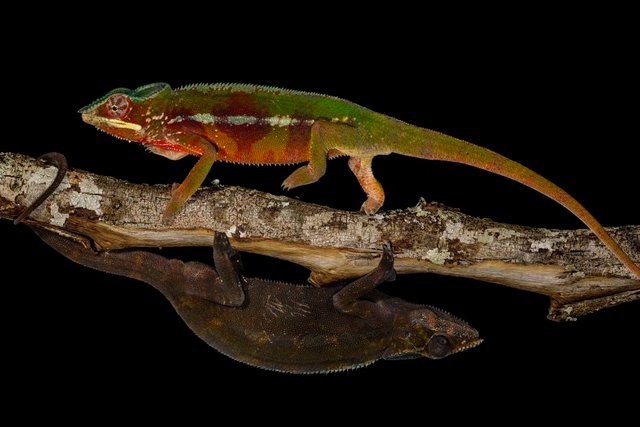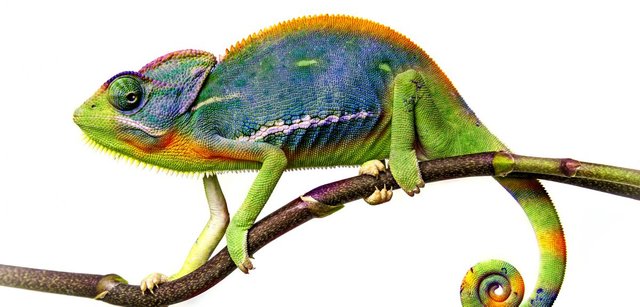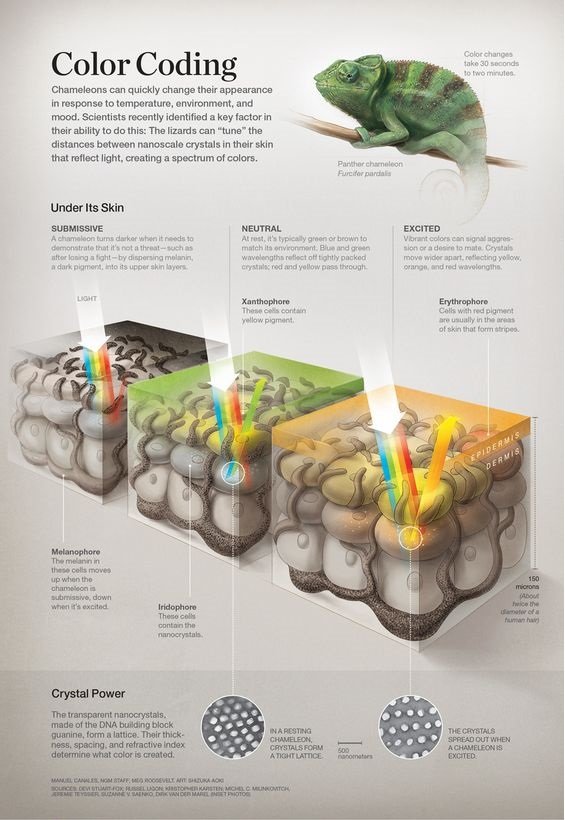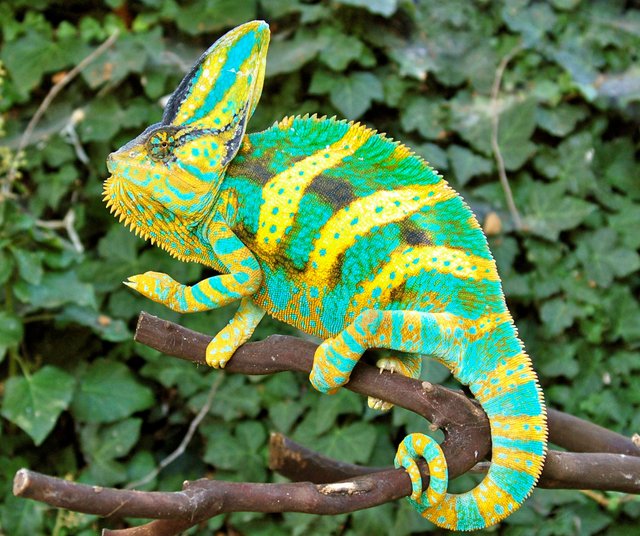Physics in the world of animals: chameleons and their color
Chameleons - very unusual animals. Their features and method supplies, and vision system, and the ability to change the color of the body, depending on various factors. Previously, scientists believed that the chameleon has developed a way to masquerade as the environment, protecting from predators. In fact, chameleon changes color depending on the temperature, illumination, and mood occurring physiological processes in the body (for example, female pregnancy).
How does an animal changes color? Scientists have long ago discovered that the reason - in the pigment cells called chromatophores. These cells are translated from Greek as "paint-bearing." Their work is quite complex. Each cell in the cytoplasm contains pigments that allow the skin of the animal and change its color. The main chameleon pigment cells - melanocytes and melanophores, which contain specific organelles (melanosomes) different versions of melanin. Then there xanthophores which contain carotenoids and pteridines flavin containing pigment colors from yellow to red.
These pigments are placed in other organelles, called pterinosomy. And they are in a free state in the form of droplets, located in the cytoplasm. There are iridotsity or guanofory that contain crystals of guanidine. These crystals provide a silver or golden color. Under the pressure and influence of chemical compounds can change the location of the crystals. By increasing the distance between them changes and the spectrum of the reflected color of the skin. The higher the clearance, the greater the displacement of the spectrum from blue to green and then - to the red.
How it works?
Chromatophores most of them are the most profound and the fibrous layer of the animal skin. These cells contain the pigment grains, as mentioned above. And in some pigmented chromatophores grains more than the others. Value is also the location of the pigment in such a cell. It can be evenly distributed throughout the cell, it may be in a branched or straight in the center. Chromatophore peculiarity is that the pigment grains can be moved by such a cell.
If the processes are reduced chromatophores, pigment grains begin to be concentrated in the center of the cell. In this case, the chameleon skin looks whitish or yellow. If chromatophores are distributed by branch chromatophores skin becomes dark, sometimes black. Shades of chameleon skin color are caused by mixing pigments of both layers. Green tone characteristic of the animal occur when sunlight refracted in the surface layer. Here are distributed crystals of guanidine, which refract the rays. As a result, a chameleon can change pretty quickly their color, changing colors from white to orange. Interestingly, the change can capture only a portion of the body of a chameleon and can affect his body, from snout to tail. Chromatophores, among other possibilities, "know how" to change the depth of the skin. The higher the depth chromatophore accommodation, the paler skin. The brighter - so it is more contrast.
Why a chameleon changes its color?
This is affected by many factors. Their scientists are divided into two groups. The first group - a purely physiological factors, it is the ambient temperature, lighting, humidity, hunger, dehydration, pain. The second group - factors "emotional." These include fear, pleasure, anger and all the rest. During the period of mating male chameleon-react to each other, changing colors more vibrant when approaching the opponent. Females also react with the pregnant female has a different coloring than the normal female.
We have already mentioned that disguise - not a priority for the chameleon. But it so happened that a chameleon takes the color of the place to which the creeps. It does not always like that, but it often happens that way. And if you damage the optic nerve of an animal, it will lose the ability to change color. Scientists have for many years carried out many experiments with chameleons. A large number of observations. Among them, the most interesting are the following:
- Chameleon with damage to the optic nerve loses its ability to change its color. If a nerve is damaged in one of the eyes, the skin on the respective side of the animal's body lighter;
- If you irritate the spinal cord chameleon shock, the body becomes lighter, if you remove the spinal cord, the skin will darken;
- If chameleon lull using ether animal brightens if the same operation to carry out using chloroform - animal body darkens;
- If you irritate the central optic nerve shock, the body of a chameleon darkens.
Scientists studying chameleons, suggested that the management of the chameleon skin color is made by means of two types of centers in the central nervous system of a chameleon. The first type can be called a "willful", the second - a purely automatic. The second type of support centers tsvetoizmenyayuschuyu system in a certain tone. These centers are influenced by "strong-willed" centers which inhibit the action of automatic centers. The first cause darkening, second - skin bleaching.
Referenced Materials:
- https://en.wikipedia.org/wiki/Chromatophore
- https://en.wikipedia.org/wiki/Chameleon
- http://ngm.nationalgeographic.com/2015/09/chameleons/edmonds-text




Once again, your post seems to be a translation from this article... I will repeat my previous comment:
In the previous case, you answered me that the original Russian article was yours. Is it the case this time too? Note that the Russian author is different for the two articles.
their colors are so amazing
yeah, it's true
Never knew they could project so many color schemes.
This post has been ranked within the top 50 most undervalued posts in the first half of Dec 11. We estimate that this post is undervalued by $7.07 as compared to a scenario in which every voter had an equal say.
See the full rankings and details in The Daily Tribune: Dec 11 - Part I. You can also read about some of our methodology, data analysis and technical details in our initial post.
If you are the author and would prefer not to receive these comments, simply reply "Stop" to this comment.
Plagiarism is never undervalued.